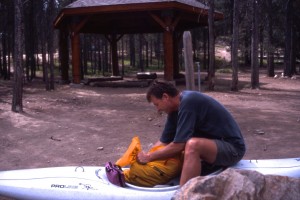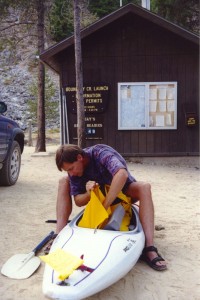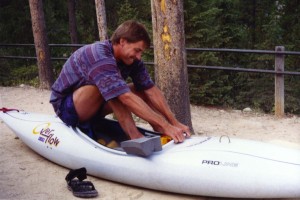
Loading stow floats into the rear of my kayak is the worst part of my river day. Times ten. Don’t believe it? Just check out the last few clips of my morning at Fly Camp in my “Wild River” video. They were included specifically to give some idea of the effort it often takes to insert these recalcitrant beasts in to a boat. The good news is that the chore tends to get easier a few days into the float after some of the food is consumed. However, I have threatened on more than one occasion to leave all the food behind at the start of many trips, when inserting the recalcitrant devils into my boat seemed all but impossible. Here are a few tips to easing them into and out of a boat. Ideally, lighter weight, smaller items will be loaded into the small end of the bag first, with heavier gear towards the opened end in order to achieve proper weight distribution. However, in competent whitewater river runners, I’ve never found this last concern to be all that critical on the rivers I run.
-

Open Stow Floats – Boundary Ck. MF Salmon 1996 (photo by Mary) Move the seat forward as far as possible.
- Ensure any pillared items (i.e., peli box) are inserted into the pillar before beginning.
- Make certain all the pieces of your TAP are in place, or anything else for that matter, if they are indeed stored in the stern.
- OPEN your stow float’s inflation valves (…DOH!).
- The reality of modern river runner design is that the rear deck can take a pretty severe dive down to the cockpit, choking off the entry point of all that stern volume. This is the bugaboo which must be overcome in many boats. The bags WILL fit (…I keep telling myself), if they can pass that point. Leave bulky items, like cookware, stoves, or off river pile garments out of the bags until they have been wrestled most of the way into the boat. Stuff bulky items up into the open bag.

Foot Assist – Boundary Ck. MF Salmon 1996 (photo by Mary) When filled, close securely and push them the rest of the way in. Don’t be afraid to use your leg strength and feet to help push them in. Full of gear, it won’t take but a few breaths to inflate them once they’re all the way in.
- Remember, if at first you don’t succeed…
If you have them, place extra containers or bags ahead of your bulkhead. I have carried a collapsible water bucket (a requirement on some rivers) either there or next to the hull on the opposite of my seat from my sponge. Make sure all day bags, throw ropes, water bottles, camera bags, etc. are carabinered securely into your boat. Don’t leave anything loose that you cannot afford to lose. While I am not all that concerned about losing gear on river, items can get misplaced and left behind somewhat easily off river, when exiting the boat or emptying it.
